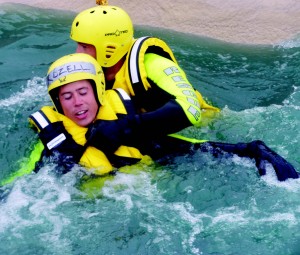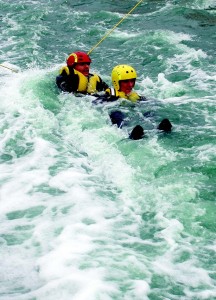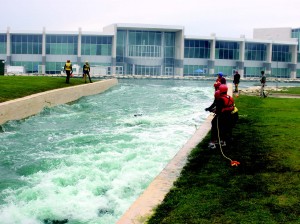By Edna Horton/nw news editor


Several area firefighters appeared to fight for their lives during swift water training Sept. 23 on NW Campus.
TCC has the only swift water simulator in Tarrant County, and firefighters from Grapevine, Denton, Plano and Kennedale were on hand to receive tethered swimmer training and live bait training.
Chief Wes Rhodes of the Haltom City Fire Department said swift water training started about four years ago on NW Campus when the facility was built. Until that time, training was done at Six Flags in Arlington on the Roaring Rapids ride.
“I don’t know of any college or fire department in Tarrant County that has this simulation,” Rhodes said.
The training facility was needed in Texas so firefighters could learn how to know their limits and how to handle themselves in high and fast-running water so they would not become victims themselves, Rhodes said.
“Anywhere in Texas, we go through periods where it is very dry for three or four days,” he said. “Then we get four or five inches of rain in a short period of time, and there are creeks that can’t take it, and flash flooding occurs.”
The swift water training technician class is held three times a year in May, July and August. The training is regional and includes fire departments from all over the state and even some from out of state.

“We get several firefighters from all over Texas and have even had some come from Oklahoma for training,” said James Craft, assistant coordinator for NW fire training service.
Fourteen Tarrant County cities have formed a group called Northeast Fire Department Association. They have a swift water training team and have all been trained on NW Campus.
Craft, Jonathan Mercer of Mansfield and Jason McGill of Arlington provided last week’s training.
“Over 80 percent of water-related fatalities are rescue personnel that have not been properly trained,” McGill said.
The training provided to the different cities is funded by grant money, McGill said. Many cities, including Denton, are now forming teams trained in water safety.
The training is a simulation allowing instructors to teach students in real-life situations. The simulator is a big concrete river that water quickly rushes through.
Students divide into two groups and take turns being victims and rescuers.
In tethered swimmer training, the victim is in the water while the rescuer is tethered to a rope that two other rescuers are holding.
Once the tethered rescuer enters the water, the two rescuers holding the rope race along the bank while the other rescuer floats head up, hands up, feet up in the water. After the in-water rescuer has secured the victim, the rope holders pull the victim to safety.
A rope is tied across the end of the simulator for the live bait training. The victim holds on to the rope. He is the live bait. The rescuer floats on the current to the victim. Once he has the victim, he secures the victim to his safety vest and swims back to the bank.
Every rescuer is told to hang onto the backside of a solid structure such as a branch or the pillar of a bridge. Doing this keeps rescuers out of the current, allowing them to swim to the bank and save the victim.
For more information about TCC’s fire safety training programs, contact the fire technology center at 817-515-7172.

























